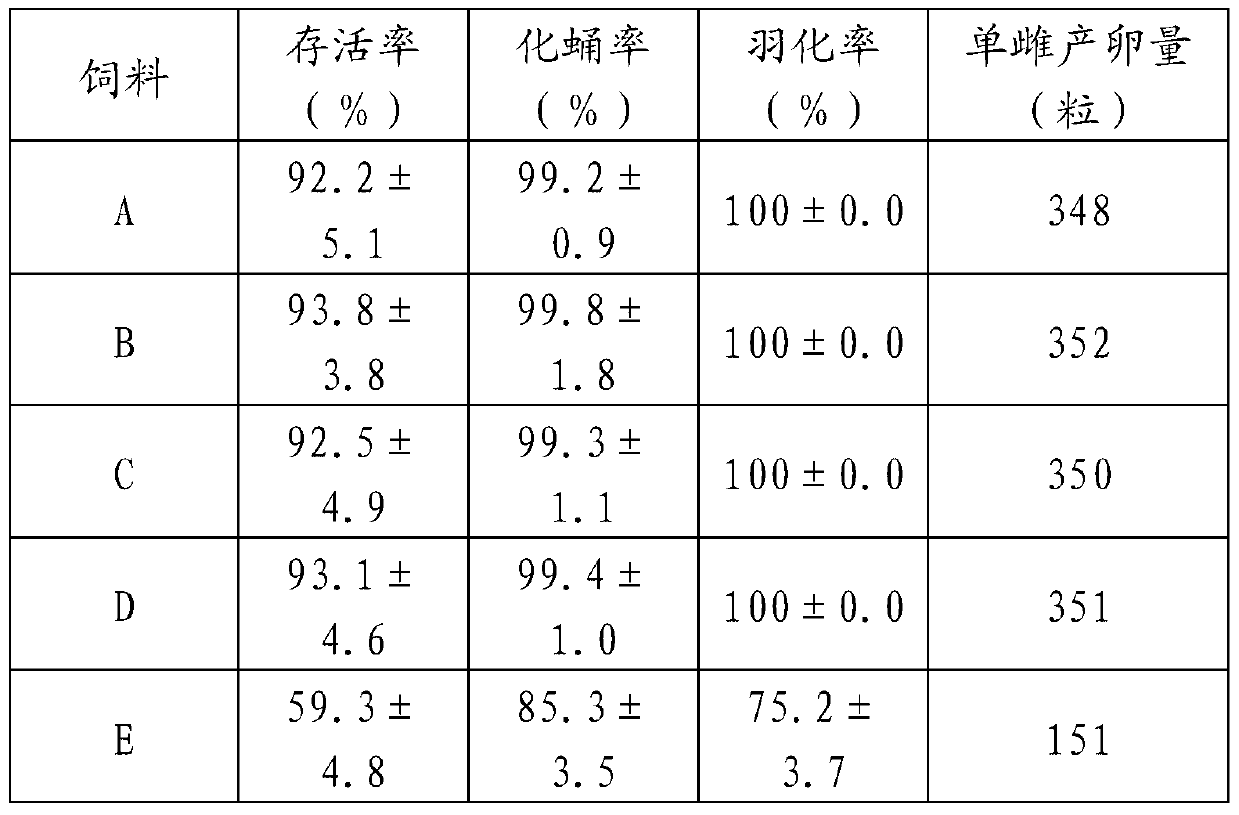Method for artificially rearing athetis lepigone for test
A two-point spodoptera, artificial technology, applied in animal feed, animal feed, application and other directions, can solve the problems of reducing the survival rate of larvae, increasing the workload of the staff, increasing the phenomenon of self-mutilation, and improving the survival rate and reproduction rate. , reduce reproductive costs and risks, and improve the effect of feed utilization
- Summary
- Abstract
- Description
- Claims
- Application Information
AI Technical Summary
Problems solved by technology
Method used
Image
Examples
Embodiment 1
[0040] A kind of artificial rearing method for testing two o'clock moth, mainly comprises the following steps:
[0041] (1) Choose a fresh-keeping box with a diameter of 14cm and a height of 8cm, put a filter paper with a slightly smaller diameter in it, and drip water on the filter paper to make the filter paper moist;
[0042] (2) Transfer the eggs laid by adults of Spodoptera spp. in the same period of time to the fresh-keeping box described in step (1). After hatching the larvae, transfer each larvae to a container with a diameter of 2 cm and a height of 6 cm. Single-head feeding with synthetic feed blocks in glass tubes;
[0043] (3) After feeding for 20-24 days, the larvae are nearly mature and pupate, and no feed is added; the pupae are transferred to a sterilized petri dish with a diameter of 5 cm and a height of 0.5 cm, with 10 male and 10 larvae in each dish;
[0044] (4) Put the petri dish with pupae in step (3) into a glass bottle with a diameter of 9 cm and a hei...
Embodiment 2
[0053] A kind of artificial breeding method for testing the two-spot moth, is characterized in that: mainly comprises the following steps:
[0054] (1) Choose a fresh-keeping box with a diameter of 16cm and a height of 9cm, put a filter paper with a slightly smaller diameter in it, and drip water on the filter paper to make the filter paper moist;
[0055] (2) Transfer the eggs laid by adults of Spodoptera spp. in the same period of time to the fresh-keeping box described in step (1). After hatching the larvae, transfer each larvae to a container with a diameter of 3 cm and a height of 8 cm. Single-head feeding with synthetic feed blocks in glass tubes;
[0056] (3) After feeding for 20-24 days, the larvae are nearly mature and pupate, and no feed is added; transfer the pupae to a sterilized petri dish with a diameter of 6 cm and a height of 1 cm, with 10 male and 10 larvae in each dish;
[0057] (4) Put the petri dish with pupae in step (3) into a glass bottle with a diamete...
Embodiment 3
[0066] A kind of artificial breeding method for testing the two-spot moth, is characterized in that: mainly comprises the following steps:
[0067] (1) Choose a fresh-keeping box with a diameter of 18cm and a height of 10cm, put a filter paper with a slightly smaller diameter in it, and drip water on the filter paper to make the filter paper moist;
[0068] (2) Transfer the eggs laid by adults of Spodoptera spp. within the same period of time to the fresh-keeping box described in step (1). After hatching the larvae, transfer each larvae to a container with a diameter of 4 cm and a height of 9 cm. Single-head feeding with synthetic feed blocks in glass tubes;
[0069] (3) After feeding for 20-24 days, the larvae are nearly mature and pupate, and no feed is added; the pupae are transferred to a sterilized petri dish with a diameter of 6 cm and a height of 1 cm, with 10 male and 10 larvae in each dish;
[0070] (4) Put the petri dish with pupae in step (3) into a glass bottle wi...
PUM
| Property | Measurement | Unit |
|---|---|---|
| Diameter | aaaaa | aaaaa |
| Diameter | aaaaa | aaaaa |
Abstract
Description
Claims
Application Information
 Login to View More
Login to View More - R&D
- Intellectual Property
- Life Sciences
- Materials
- Tech Scout
- Unparalleled Data Quality
- Higher Quality Content
- 60% Fewer Hallucinations
Browse by: Latest US Patents, China's latest patents, Technical Efficacy Thesaurus, Application Domain, Technology Topic, Popular Technical Reports.
© 2025 PatSnap. All rights reserved.Legal|Privacy policy|Modern Slavery Act Transparency Statement|Sitemap|About US| Contact US: help@patsnap.com

